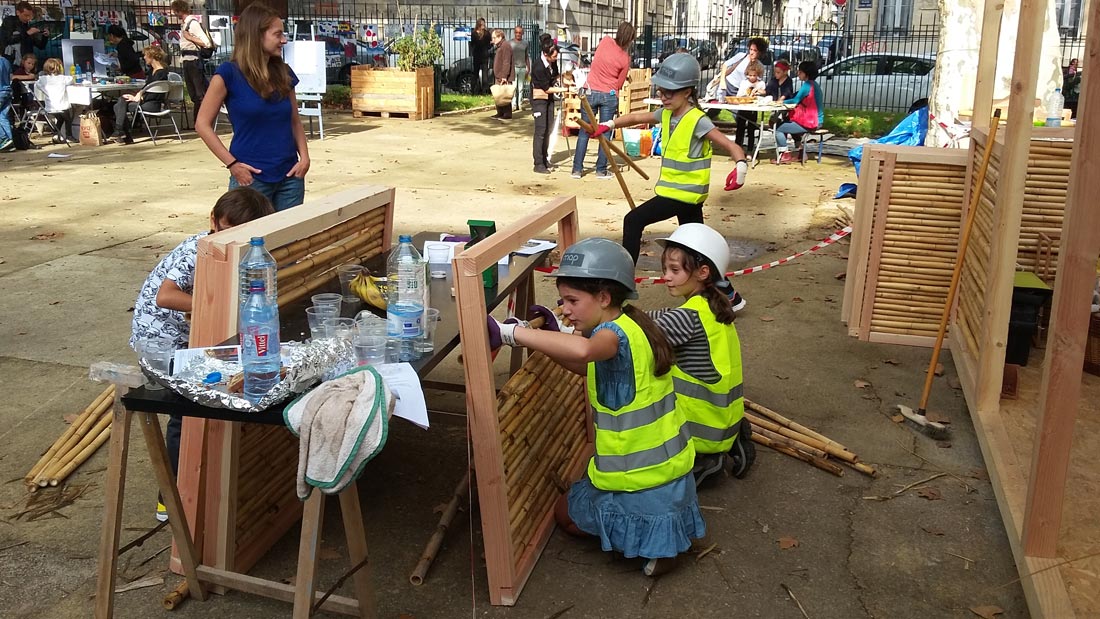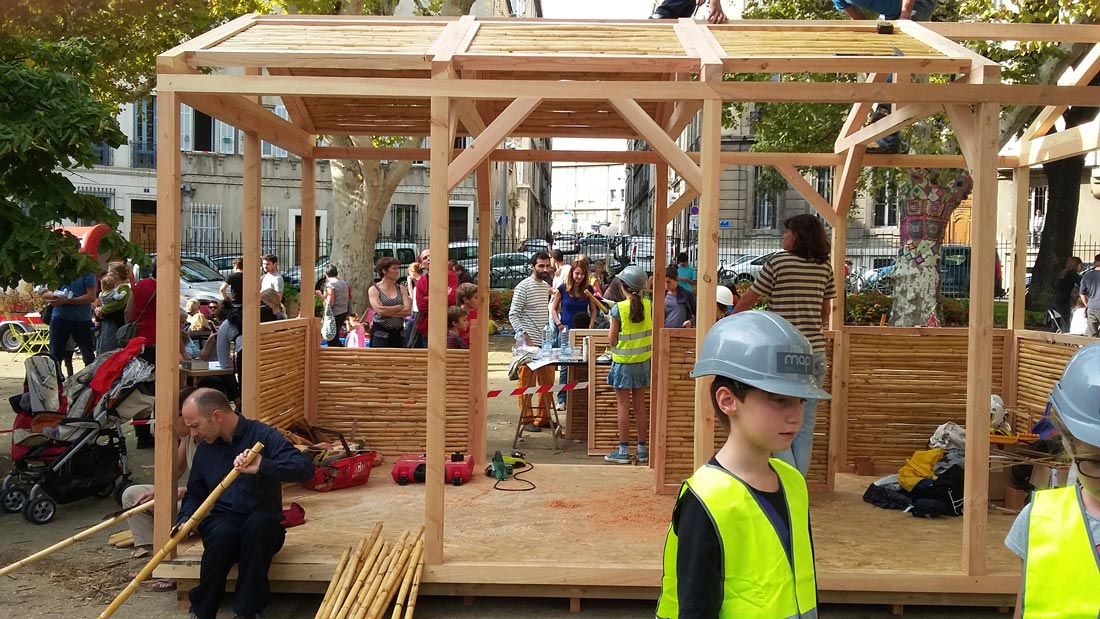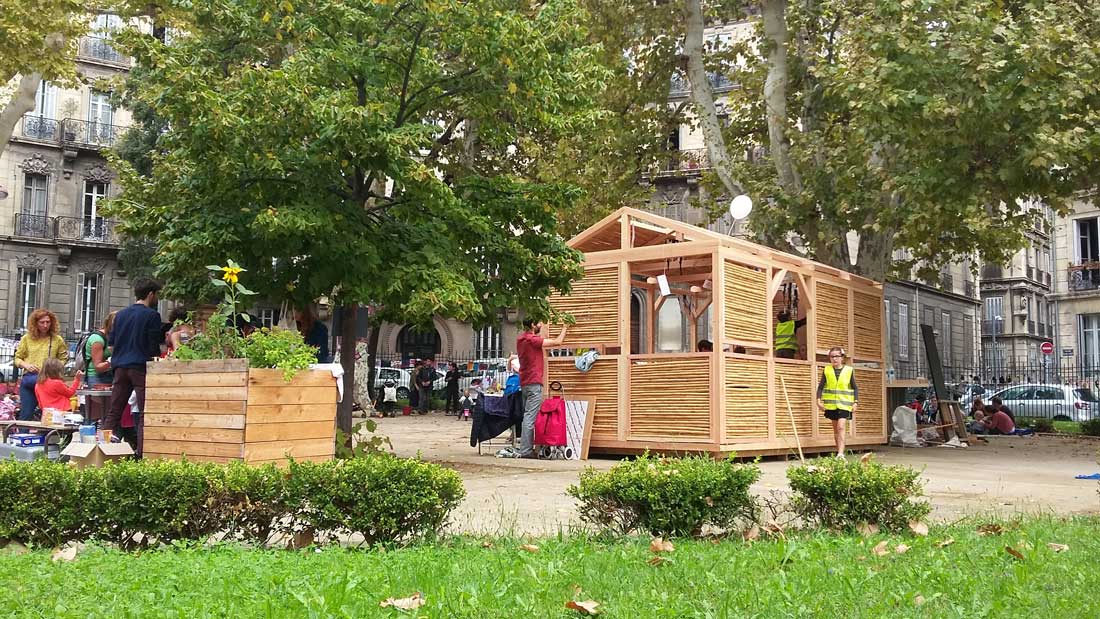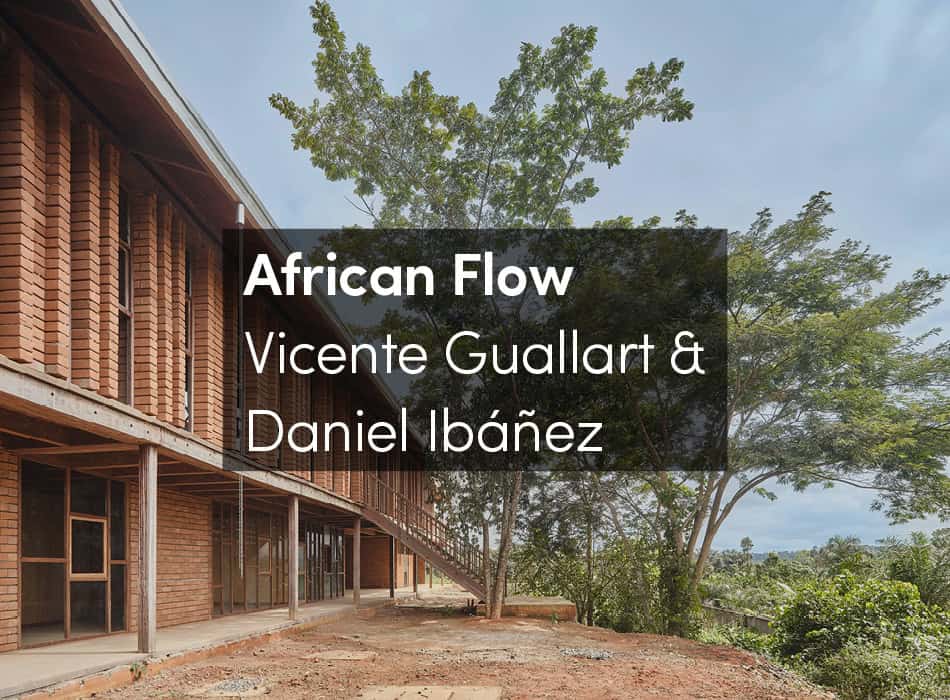An 8-meter black and white canvas with a direct message “Children are dangerous” was hung at the top of the stairs along the square in front of the main entrance to the I Lyon Architecture Biennale.
This provocative message was intended to create a debate about the role children play in the creation of the cities we live in and their relation with the powers that decide on city design understood in terms of spaces, but also how the city can be used and by whom.
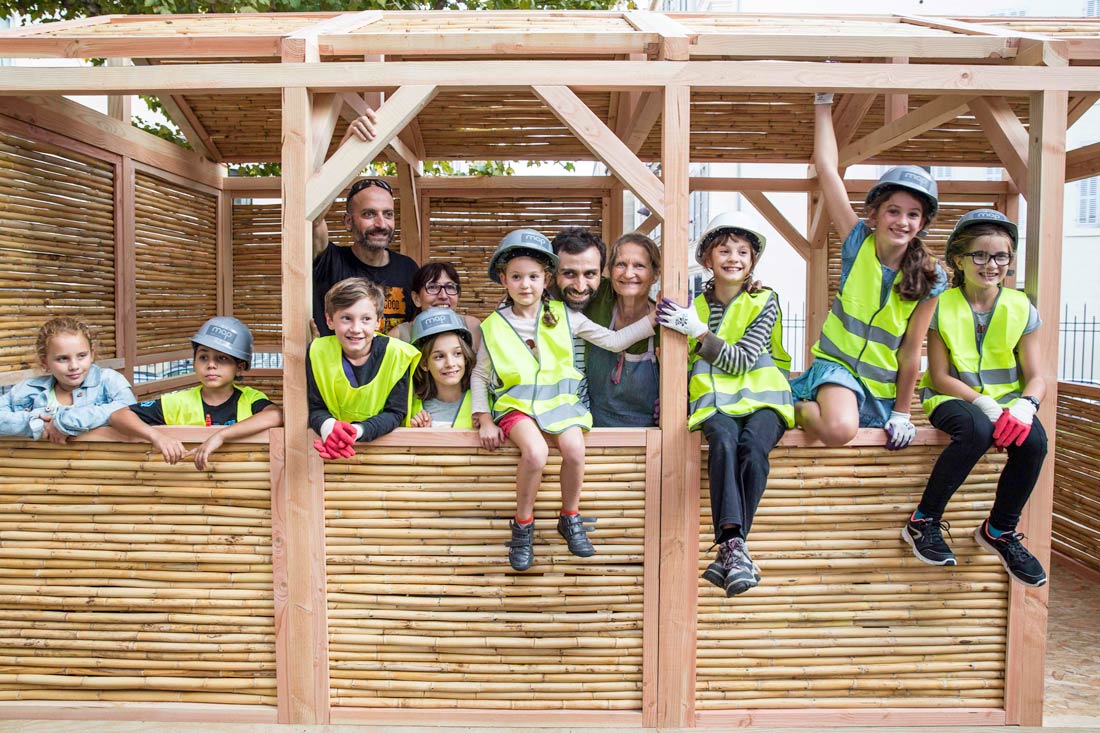
These reflections were inspired by the work of Francesco Tonucci and his La città dei Bambini.
Children are VERY dangerous!
Because they are citizens who still dream of green cities, happier cities, not only for them, but for all!
Because children ask us about aspects of the city that adults take for granted; They do not accept the model of the present city as an unalterable entity.
Because they are not afraid to imagine diversity.
Because their apparent simplicity shatters a useless complexity.
Because they have the ability to reinvent parts of the world without prejudice.
Becaused they are courageous and contagious!
Because their point of view can help us imagine cities that are easier to live and introduce new perspectives in the urban debate.
Because listening to them is a way of bridging the distance between city planners and administrators and citizen users.
Because they can help us to adopt a new point of view regarding the city, its neighborhoods, its public spaces: a funny, curious, innovative and audacious point of view!
Are we, the politicians, the city planners, the local administrations, and adult society in genearl, ready to listen to them in order to plan happier cities together or ARE WE AFRAID OF CHILDREN?
The barriers that prevent children from playing an active role and contributing to the urban debate and to the construction of our cities of the future are the same barriers faced by other citizens in different age ranges. But while other have accepted this situation, children try to break through it with their innocence and energy.
In Europe, children make up between 15% and 20% of the population, but their voices are not considered in the urban debate… because they are “the citizens of tomorrow”. Meanwhile cities are becoming grayer and less livable every day, designed with other priorities in mind – cars, adult leisure, consumption – which limits their freedom to live the city as it becomes hostile to children for many other social categories.
This was the reflection that led to our idea:
Children are not the citizens of the future; they are citizens today, RIGHT NOW!
The Yona Pavillon: An example of children’s involvment in urban management at a neighborhood scale
The “Yona Pavilion” was built on Alexandre Labadie Square in early October 2016. This square is located in the heart of the 1st district of Marseille and its circular space, which is part of a dense urban fabric rich in history, was not classified as public space. It was open to the public only for specific events and normally closed to the public to protect the vegetation from acts of vandalism. At the start of the project it was in a state of desolation and abandonment.
The desire of the boys and girls of Les ArchiMinots association was to regain the public control of this space, enhance it and make it accessible to the public.
Les ArchiMinots is a cultural association offering architecture workshops for children in the 1st district of Marseille. Every year, in addition to the various activities carried out in the laboratory, a “lighthouse” project is developed in the city. In 2016 the Yona Pavilion, a wooden structure, with a rectangular plan of three meters by five meters, was conceived and designed, with a cladding made from Provence reeds.
The entire preparation process took one year. The final result came into being through experimentation, models, prototypes, reflections and research into opportunities for recycling materials. For example, the Provence reeds used in the closure panels were donated by a company that produces saxophones, which uses only a small and specific part of the reeds for its instruments.
The opportunity to build the pavilion was presented during the POC festival (Porte Aperte rue Consolat), which for 15 years has allowed craftsmen, artists and associations of the 1st district of Marseille (the district where most children who regularly participate in LAM workshops reside) to present their work to the city and visitors.
The work of the boys and girls who took part in the event drew attention to the dichotomy between public space and inaccessibility.
The construction – with the participation of almost 40 boys and girls – and the inauguration of the pavilion were accompanied by events that highlighted the value of this project for the redevelopment of the public space.
Strengths
1. Process of materials and site search
2. Rehabilitation of an otherwise unused urban space
3. Self-construction with the help of about 40 girls and boys
4. Group work involving numerous associations
Difficulties and challenges
1. Research of recycled material
2. Permit requests for building
3. Preparation of the participanting children group to work safely on the site
4. Involvement of boys and girls living in the neighborhood
The district committee decided to make this square a point of reference for further actions. The square will be open to the public for events and associative initiatives. Thanks to this project, the association Les ArchiMinots was invited to attend the next International Architecture Biennale in Lyon. For the first time, children will take part in an architecture biennial as the authors of a proposal.
The working group of “assistant girls and boys” includes: Daphne, Rosa, Valère, Violette, Valeria, Celeste, Paule, Gabriel. Around 40 boys and girls participated in the final executive phase of the project.
Parcc Oasis: Third places, actors of democracy
The PARCC Oasis is a collective and an inter-associative space installed since the end of 2016 on a former industrial wasteland, future eco-district, in Clermont-Ferrand.
Since its occupation (permitted by the city), the collective has been proactive in participative building sites, workshops, discussions about organization and self-management, festive events, etc.
PARCCO proposes an answer to two societal issues:
– Occupying vacant spaces in the city, developing them, breathing life into them, make them live !
– Bringing together associative actors to exchange knowledge on practices and projects.
From the outset, the PARCC Oasis collective chose the all-collective, all-participatory approach. Thus, each volunteer (subject to having the necessary information and available time) can be an actor in the choice of the project’s values and actions.
Being an actor in the choice of collective values
It is not in the interest of this kind of citizen project for everyone to agree. Debate makes it possible to work towards a consensual agreement, which adds to the strength of the collective.
The mere fact of giving one’s word independently of others (the preliminary round at any time of debate) creates an atmosphere that is conducive to democracy from the outset.
For example, several periods of exchange and consultation between the associative and individual actors in the project made it possible to co-write what will serve as the”manifesto” for the project. This manifesto of values, fuelled by everyone, discussed by everyone, and thus accepted by the collective, remains open and evolving.
Linking theoretical and practical commitments
Democracy is the power of decision in the hands of citizens. But it is also the power to act, and to implement the actions that flow from and represent the decisions that have been made.
Everyone can express themselves and propose actions according to their availability and desires – subject to respect for the collective and its manifesto. To make a mound for gardening, to organize a workshop focused on manufacture or discovery, or even to build a small building, everyone is invited to participate in the proposal of actions and their implementation. An proposal for action that corresponds to the collective’s desires, based on “listening to the centre”, has every chance of being retained and supported by everyone, and thus of being realized.
Popular education
When money is divided, everyone gets richer in the amount of his share, but the donor gets poorer in the total amount that has been distributed. The exchange is fatal, unidirectional and irreversible, even perverse (the impoverished will tend to become even poorer). The operation of knowledge exchange works with an inverse logic and an incomparable power. An exchange of knowledge in no way impoverishes the demonstrator, it enriches the listener and makes him want to express himself in return and enrich the common pot of knowledge.
Popular education is a means of exchanging knowledge and know-how by freeing oneself as much as possible from a classical vertical learning pattern (knowing it gives information to the learner). In a popular exchange, one or more people are at the origin of a session involving training, discovery and exchanges focused on a theme or practice. Everyone can contribute to enriching and complementing the collective knowledge, testify to his way of doing things or share his experience. Expert or not, one can exchange during a discovery workshop, learn from others and teach others.
Sharing knowledge and resources is a method of rediscovering democracy, and these exchange relationships are probably a sound basis for any democratic functioning.
The impact on “political” democracy
Participation in a citizen-centered collective project such as that of the PARCC Oasis sometimes makes it possible to free oneself from certain institutional intermediaries whose modes of operation (deadlines, communication, regulations, etc.) and values are sometimes poorly adapted to the expectations of the project.
The means of communication provide a faster transmission of information to make decisions and act to implement changes in the material and ecological plan.
This working method can be a successful democratic operation for a limited number of individuals and structures, in cases where the project scale is appropriate (generally on a local scale).
It seems essential for these groups to structure and organize themselves in order to clearly define a field of application for the democratic operation, even if it means inserting themselves into regulated or institutional schemes.
The use of regulated statutes and effective structuring are sometimes necessary to work with structures such as schools, social action centers and communities and to maintain a link with the democratic structures of the nation.
In conclusion, a “third place” initiative (in the sense of a place parallel to the home and the workplace), is a space where the values of a Social and Solidarity Economy can be promoted, where democracy is an integral part. The mutualization of means of thought and of obtaining or not obtaining power are, in turn, to be defined in parallel in order to fix a slider adapted to the democratic needs of the collective space.






